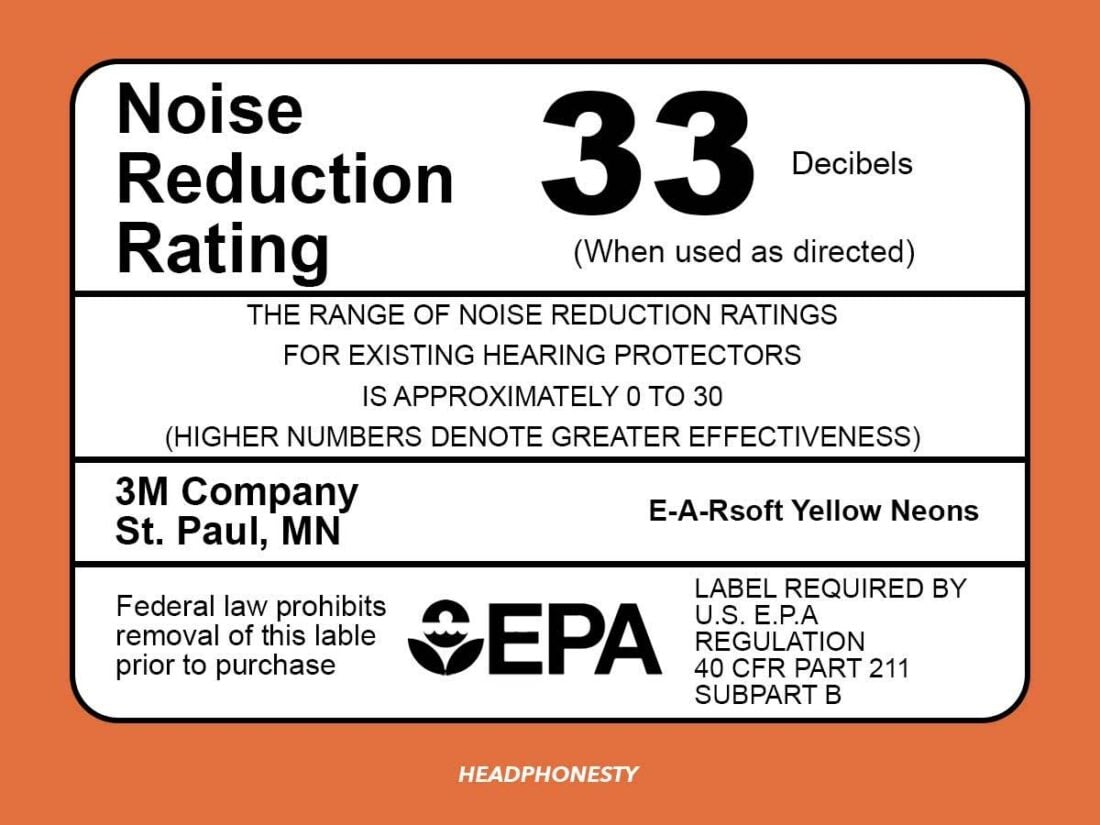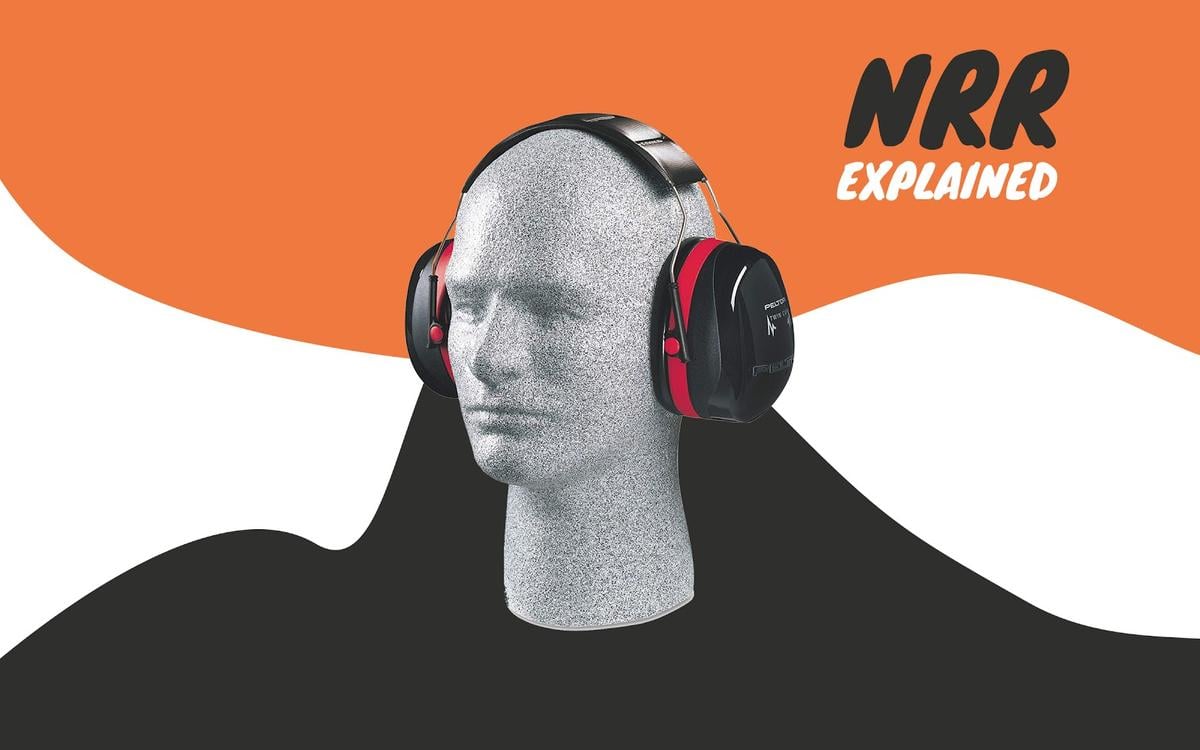Understand the basics and importance of Noise Reduction Ratings (NRR) to protect your hearing.
Noise Reduction Rating (NRR) is one of the principal factors users look for when hunting for Hearing Protection Devices (HPDs).
Unfortunately, understanding the NRR of HPDs can be complex, as it’s not always clear how much noise they’ll reduce in real-world situations.
This article goes over the measurements and calculations that will help you understand what the NRR on hearing protection really means when it comes to the amount of noise it reduces. Let’s get started!
What Is Noise Reduction Rating (NRR)?

A Noise Reduction Rating indicates a hearing protection device’s ability to reduce the noise level coming into the user’s ears from external surroundings.
It is the official standard for attenuation in the USA and serves as a reference point for buyers looking for HPDs. The rating shows how effectively a device attenuates external noise. The higher the rating, the more effectively the HPD will reduce noise exposure.
An HPD with an NRR of 31 can ideally reduce noise by 31 decibels (dB) in controlled lab conditions. However, as we’ll explore in later sections, NRR and actual noise reduction don’t maintain a 1:1 relationship in everyday situations.
How Much Noise Reduction Do You Need?
Before getting into how much noise reduction an HPD with a given NRR will actually provide, you might want to first figure out how much noise reduction you need in the first place.
For a quick reference, here’s breakdown of the time and dBA thresholds for excessive noise according to OSHA and NIOSH:
| Maximum duration per day | Excessive noise threshold per NIOSH REL | Excessive noise threshold per OSHA PEL |
|---|---|---|
| 8 hours | 85 dBA | 90 dBA |
| 4 hours | 88 dBA | 95 dBA |
| 2 hours | 91 dBA | 100 dBA |
| 1 hour | 94 dBA | 105 dBA |
| 30 minutes | 97 dBA | 110 dBA |
| 15 minutes | 100 dBA | 115 dBA |
Thankfully, measuring noise levels is pretty easy. Decibel meters, also called sound pressure level (SPL) meters, are simple and inexpensive devices that will measure the noise level of your environment in dBA. You can also use an app to measure noise levels if you’re trying to keep things as simple as possible.
Once you have measured the noise levels to which you’re exposed, subtract 85 to 90 dBA from the reading on your SPL meter/app. The number you’re left with is the minimum amount of noise reduction in dBA that you’ll need for 8 hours of safe noise exposure, as per the above table.
How to Calculate Actual Noise Reduction Based on NRR
NRR is the critical variable in calculating the amount of noise an HPD will reduce in a real-world setting. As mentioned earlier, the NRR on an HPD can’t be taken at face value as it only indicates the number of decibels the device can attenuate under ideal lab conditions.
Below are different ways to calculate the amount of real noise reduction provided by an HPD by using its NRR according to OSHA and NIOSH’s derating formulas.
Calculating noise reduction based on NRR: OSHA method
The U.S. OSHA’s (Occupational Safety and Health Administration) method of calculating the total noise reduction of and HPD in dBA based on NRR is as follows:
Let’s apply the formula by using an example of an HPD with an NRR of 28. To find how much noise it will reduce in dBA, we would do the following:
So, based on the OSHA method of calculating noise reduction, we can say that an HPD with an NRR of 28 will reduce noise by 10.5 dBA.
Calculating noise reduction based on NRR: NIOSH method
The U.S. NIOSH (National Institute for Occupational Safety and Health) method differs slightly from the OSHA method. Most importantly, it considers the type of HPD in use.
The NIOSH method for calculating noise reduction in dBA based on an HPD’s NRR is as follows:
Ear muffs: [NRR-(NRR*0.25)]-7 = Amount of noise reduction (dBA)
Formable earplugs:[NRR-(NRR*0.5)]-7= Amount of noise reduction (dBA)
All other earplugs: [NRR-(NRR*0.7)]-7= Amount of noise reduction (dBA)
Let’s use an example of an HPD with an NRR of 28 and apply the NIOSH method. We’ll also say that the HPD in question is a pair of earmuffs. We can calculate the amount of noise reduced in dBA according to NIOSH with the following calculation:
Single Number Rating (SNR) vs NRR: What’s the Difference?
While the NRR is the standard for hearing protection attenuation across North America, the Single Number Rating (SNR) is the EU standard. The main difference between SNR and NRR is that the former’s ratings are typically a few decibels higher due to different lab testing procedures.
Like NRR, SNR provides an estimate of an HPD’s level of noise reduction in controlled lab conditions. Calculating the real amount of noise reduction in dBA that an HPD can provide by using SNR varies from country to country. The UK, however, uses the most simple and straightfoward calculation:
SNR is frequently paired with HML values, which indicate whether an HPD is most effective at attenuating high, medium, or low-frequency sounds (indicated with an H, M, or L, respectively).
Frequently Asked Questions
- Can you improve the amount of noise reduction provided by hearing protection devices?
- Which hearing protection devices have the highest NRR?
- How are noise reduction ratings tested and determined?
- Who came up with NRR?
- Can I listen to music with hearing protection devices?
Can you improve the amount of noise reduction provided by hearing protection devices?
Yes. Dual noise protection, or wearing two sets of hearing protection devices (earmuffs on top of earplugs, for example), can improve noise reduction anywhere from -4 to -8dB when compared to wearing just one HPD.
Which hearing protection devices have the highest NRR?
The highest NRR for in-ear protection is around 33, and is usually found in formable earplugs, like 3M’s Uncorded, Disposable, Foam Earplugs since they adapt better to the users’ ear shape. On the other hand, the highest NRR for on-ear protection like earmuffs is 31, as is the case with the 3M Peltor X5A.
How are noise reduction ratings tested and determined?
Entities that manufacture and sell HPDs must test the same in a testing facility that complies with the EPA’s regulations. Consequently, they must test the device on ten different trained human subjects under anechoic conditions, using 9 test frequencies.
Who came up with NRR?
The U.S. Environmental Protection Agency (EPA) came up with the definition of NRR in the 1970s, under their Noise Label Program.
Can I listen to music with hearing protection devices?
Many HPD’s do in fact double as headphones, such as the PRO 037 – just one example of many.

I’ve been looking for appropriate ear plugs for motorcycle use. I’ve gravitated towards those offered to the european market, especially those with a stated SNR. I prefer the SNR because usually low, medium, and high frequency attenuations are available for the product or included in instructions. On a motorcycle, there is usually a cacophony which varies greatly depending on conditions. Some of these are good to hear and some not so good, especially on a motorcycle. In calculating the derated SNR for an earplug with an included list of various frequency attenuations, can the -4 derated value be applied to all or certain frequencies listed, or does this derated value only apply to the stated SNR and not a certain frequency?
Appreciate Chief Editor’s introduction. This information is very useful. Look forward to seeing some introduction about the measuring process of SNR and NRR!
You need highly-specialized component to measure SNR and NRR. No consumer-friendly options as far as I’m aware.
Products like Alpine SleepDeep claim to provide the maximum noise attenuation possible – 27 dB. Cheap foam earplugs (“disposable”, but seem reusable to me) have an NRR of 33 (dB). Is the cheapest product better than the “maximum”, or am I being confused / misled by two different rating systems?
I have no need to hear anything thru the noise reducers – I’m not on a work site or at a concert. I’m not seeking hearing protection.
I’m desperate to sleep. Footsteps from the apartment above me (in an old house) combine thud and creak. Also traffic noise. There is carpet (old) on the floor above which might reduce click clack noise, but seems to have zero effect otherwise.
I am interested in combining earplugs and earmuffs, preferably where rolling on my side won’t cause the earmuffs to physically wake me
I wonder if active noise cancelling headphones will help.
Thanks for the most comprehensive article on noise ratings. Somehow I couldn’t quite apply it to understand what would be a good solution to my needs. Help?
Seems the bottom line is that the decibel rating of a headset is essentially meaningless. You have to do a bunch of math to figure out how much hearing protection you’re really getting? Why don’t they come up with a rating system that just gives the actual rating of the device? I guess my rule of thumb from here on out will be, Pick the highest decibel rating you can get, and it’s not as high as you think.